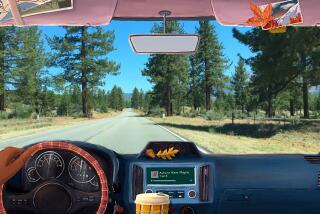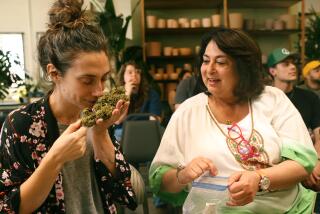Fall Is the Best Time to Plant
While working in the front yard the other day, a neighbor told me about the new raised beds he’d built over the summer in his back yard, sadly concluding, “Too bad it’s too late to plant.”
Whoa! Not true! Why do you think I’m digging up the yard right now? It’s actually the perfect time to plant, and the perfect weather to do it in.
It’s sunny, warm and breezy, and usually pleasant enough at this time of the year to keep you from working up a sweat, even if you’re trying to dig up tree roots the size of Volkswagens in preparation for planting.
In fact, from October through December is the best time to plant just about anything. Not just seasonal things like lettuce and pansies, but trees, shrubs, ground covers, herbs, bulbs and especially native plants and drought-resistant things.
It’s far easier to list the exceptions to the “fall is the best time” rule--roses and fruit trees are more plentiful and considerably cheaper in January, and some tropicals, such as bougainvillea, citrus and hibiscus, are better planted as the weather warms up in May or June.
And, of course, there are those seasonal things, many planted in fall, but others, such as petunias and tomatoes, planted in spring.
Planted now, trees and shrubs have the time to grow a substantial root system in the warm autumn soil, and a low sun and winter rains will help, making life easier because you won’t have to water as often. So much easier that it’s just about the only time of the year I do plant (except for those seasonal things).
When spring comes the plant is able to sustain the growth that naturally explodes at that time of the year.
If you wait until spring to plant, growth will be less sure-footed, and there will be less of it. You also will need to spend a lot more time watering, and use a good deal more water in summer because the roots of new plants won’t reach very far into the soil, so they’ll still be dependent on you or the sprinklers.
The benefits of fall planting are especially true for native and other drought-resistant plants. Without all the root growth made in fall and winter, the plants are going to need frequent watering in summer, which makes them susceptible to various root rots brought on by over-watering. You will be walking a thin line between too much and too little water, a line too easily crossed.
That’s why you’ll see so many native plant sales listed during the autumn months.
Don’t be discouraged by what you see at nurseries or plant sales. Most plants do not look their best right now, but put them in the ground and give them a few months and they’ll burst forth come spring.
Seasonal plants, listed in the box on this page, can only be planted in the fall because they require cool weather to grow in and they bloom or mature during spring’s warming days. The vegetables are called the “cool-weather crops” and the flowers are called “spring flowers,” as opposed to “summer flowers.”
Thanks to modern nursery practices, you can also plant these flowers in very early spring (late February and March) from larger nursery containers and still get a respectable show, but it will be short. Planted now, some of these fall-planted flowers will bloom all winter and spring.
Flowers sold in small packs are the best buy now because they have plenty of time to grow in fall and early winter, though if you are really in a hurry for color, you can plant from the larger “color packs” or from 4-inch pots (these are the best bets in early spring).
Don’t overlook sowing things from seed. There are many handsome spring flowers unattainable any other way. Wildflowers, for one.
You can also plant bulbs and some nurseries are brim full of them. All can go into the ground right away, except tulips. In our mild climate, tulips need some chilling in your refrigerator. About six weeks should do it, though many good tulip growers wait until the end of December to plant, doing the work over the holidays.
Remember that tulips and many other traditional East Coast bulbs bloom for a very short time in Southern California, a week, or two at the most, while many of the unusual mild climate bulbs, such as freesias and sparaxis, or ranunculus and watsonias, bloom for a month or more.
Tulips are also a one-shot bulb; they will not bloom a second year and, after they bloom, you should pull them out before the foliage disappears and you can’t find them.
The mild-climate bulbs, on the other hand, are quite at home here and bloom year after year and even multiply (though many gardeners start fresh with ranunculus each fall since they are likely to rot if left in over the summer).
The cole crops are king of the fall, winter and spring vegetable garden--broccoli, Brussels sprouts, cabbage and cauliflower (and kohlrabi).
All are easy enough to grow and do best planted from nursery packs or from transplants that you’ve raised yourself. That’s because broccoli and cauliflower, in particular, tend to have a crook between roots and leaves that should be buried underground when you plant, or the plants will not stand up straight. Pull off the bottom two leaves and plant so that crook is underground. It’s similar to planting a tomato deep.
It’s a good idea to dust on some B.T., a non-poisonous biological control for the cabbage worms that relish all the cole crops. Do it right after planting if you’ve seen the white butterflies, the adults, fluttering around your garden laying eggs. Snails also love these fall-planted vegetables, so watch for them.
You can also plant most of the leaf and root crops, such as spinach or beets (and most Oriental vegetables). All are best grown from seed that sprouts quickly in the warm autumn weather.
Fall Planting Guide
From now through mid-December, you can plant the following:
FLOWERS
Annuals best started from seed: African daisies Alyssum California poppies Clarkia and godetia Linaria Sweet peas Wildflowers
Annuals and bedding plants best started from nursery packs: Bells of Ireland Calendula Candytuft Canterbury bells Chrysanthemum mulitcaule Chrysanthemum paludosum Cineraria (take shade) Columbine (take shade) Cyclamen (take shade) Delphinium
Dusty Miller English daisy Forget-me-nots (take shade) Foxglove (take shade) Hollyhock Iceland Poppy Larkspur Lobelia Nicotiana Pansy and viola Phlox Primroses (take shade) Ranunculus Blue salvia Schizanthus Snapdragon Stock Sweet William
BULBS
These bulbs should be refrigerated for six to eight weeks in the vegetable crisper: Spring-blooming crocus Garden tulips Hyacinths These bulbs can be planted right away: Alliums Amaryllis Anemones Babiana Brodiaea Calla lilies (take shade) Crocosmia Cyclamen Daffodils Dutch iris Freesia Homeria Ipheion Ixia Leucojum Lilies (take shade) Lachenalia Leucojum
Muscari Ornithogalum Oxalis Ranunculus Scilla (take shade) Sparaxis Species, or wild tulips Watsonia
VEGETABLES
These vegetables are best started from seed: Beets Carrots Endive Fava beans Kale Kohlrabi Head and leaf lettuce Peas Radish Spinach Swiss chard Turnip
These vegetables are best started from nursery packs, bulbs or bare root: Artichoke Broccoli Brussels sprouts Cabbage Cauliflower Celery Garlic Onions Rhubarb
PERENNIALS
Almost any perennial flower can be planted from 4-inch pots or gallon cans.
LAWNS
Plant cool-season grasses including annual rye over Bermuda grass lawns, perennial rye, bluegrass, tall fescue.
LANDSCAPE PLANTS
You can plant most shrubs, trees, ground covers and vines, including all California natives.
This is not the best time of year to plant citrus, subtropical vines or shrubs, deciduous fruit trees such as apples or apricots, roses or subtropical lawn grasses such as Bermuda or St. Augustine. All of these plants are about to go dormant or may freeze.






